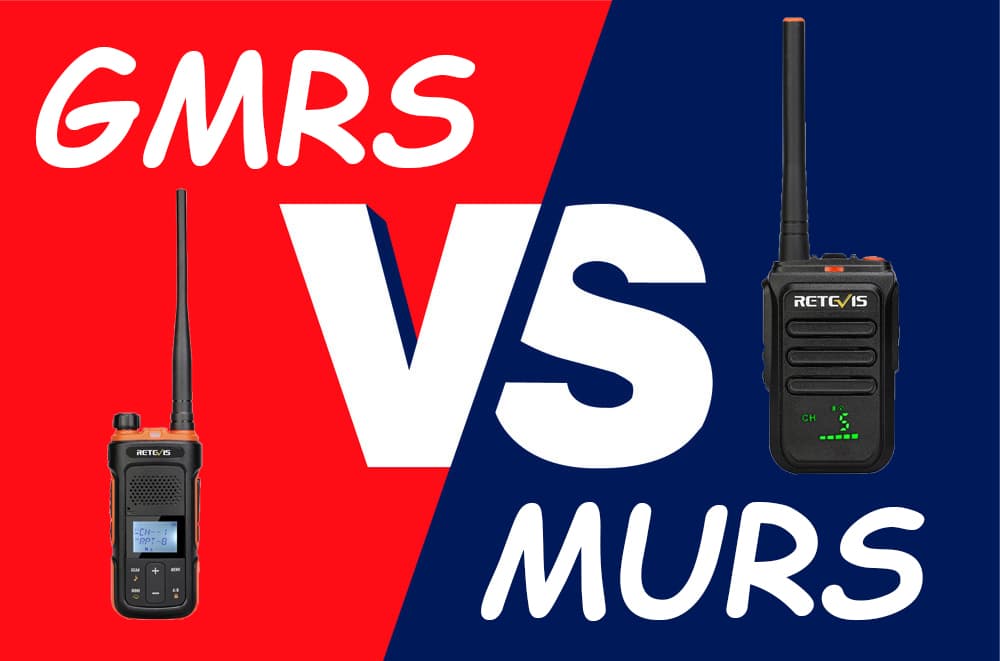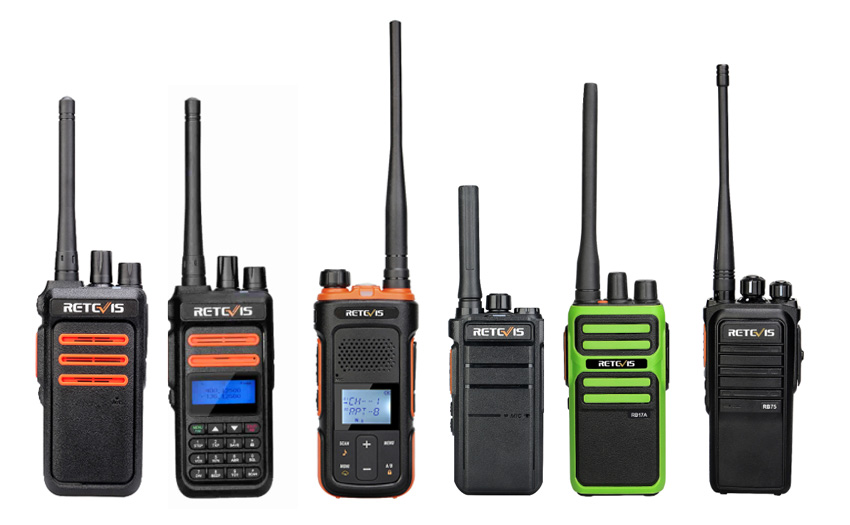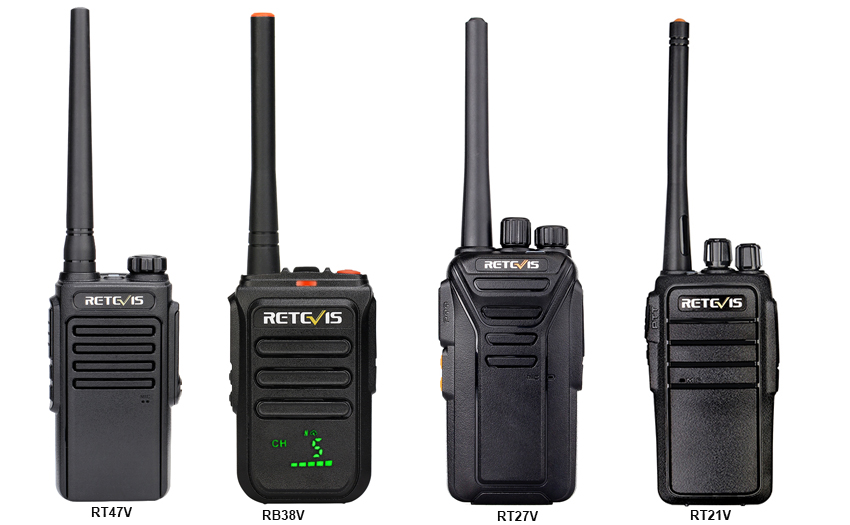What is the difference between GMRS and MURS?
- Retevis Solutions
- GMRS, MURS, Difference between GMRS and MURS, GMRS walkie talkie, MURS walkie talkie, GMRS radio, MURS radio

The General Mobile Radio Service (GMRS) is a licensed radio service that uses channels around 462 MHz and 467 MHz. The most common use of GMRS channels is for short-distance, two-way voice communications using hand-held radios, mobile radios, and repeater systems. Similar services include Multi-Use Radio Service (MURS) and Family Radio Service (FRS). In the last blog, we share the difference between GMRS and FRS, please check another email of "What is the difference between GMRS and FRS?"
Then do you know what is the difference between GMRS and MURS?

Retevis GMRS walkie talkie
First, the frequency is different.
The GMRS uses channels around 462 MHz and 467 MHz, while Multi-Use Radio Service (MURS) uses channels in the 151 – 154 MHz spectrum range(from fcc.gov).
Second, the number of channels is different.
The GMRS has 30 GMRS channels with a bandwidth of 25 kHz (20 kHz authorized bandwidth) or 12.5 kHz as outlined below:
| Channel | Authorized Bandwidth |
|---|---|
| 462.5500 | 20 kHz |
| 462.5625 | 20 kHz |
| 462.5750 | 20 kHz |
| 462.5875 | 20 kHz |
| 462.6000 | 20 kHz |
| 462.6125 | 20 kHz |
| 462.6250 | 20 kHz |
| 462.6375 | 20 kHz |
| 462.6500 | 20 kHz |
| 462.6625 | 20 kHz |
| 462.6750 | 20 kHz |
| 462.6875 | 20 kHz |
| 462.7000 | 20 kHz |
| 462.7125 | 20 kHz |
| 462.7250 | 20 kHz |
| 467.5500 | 20 kHz |
| 467.5675 | 12.5 kHz |
| 467.5750 | 20 kHz |
| 467.6125 | 12.5 kHz |
| 467.6000 | 20 kHz |
| 467.6625 | 12.5 kHz |
| 467.6250 | 20 kHz |
| 467.7125 | 12.5 kHz |
| 467.6500 | 20 kHz |
| 467.5875 | 12.5 kHz |
| 467.6750 | 20 kHz |
| 467.6375 | 12.5 kHz |
| 467.7000 | 20 kHz |
| 467.6875 | 12.5 kHz |
| 467.7250 | 20 kHz |
The MURS

Retevis MURS walkie talkie
five MURS only have 5 channels, there are five MURS channels and the channels are either 11.25 kHz or 20.00 kHz each. The channel frequencies and (bandwidth) are:
151.820 MHz (11.25 kHz)
151.880 MHz (11.25 kHz)
151.940 MHz (11.25 kHz)
154.570 MHz (20.00 kHz)
154.600 MHz (20.00 kHz)
Third, GMRS and MURS power difference.
GMRS operators are permitted to transmit at up to 50 watts, on the 16 main channels, but transmitting 1W to 5W is more common in practice. MURS with a power limit of 2 watts.
Fourth, talking range difference.
Theoretically, the range between two GMRS hand-held units would be about 2.5-3.5KM, mobile units have higher antennas and a range of around 5 miles (8 km). A GMRS repeater with an antenna that is high above the surrounding terrain can extend the usable range over a wide area – for example, up to a 20–mile (32.2 km) radius around the repeater station. While the MURS range will vary, depending on antenna size and placement. With an external antenna, ranges of 10 miles (16 km) or more can be expected. For ordinary original antennas, the communication distance of MURS is usually around 1.5km. Compared with MURS, GMRS can help you get longer radio communication distance.
Fifth, whether to allow connection to the repeater.
MURS stations may not be connected to the public telephone network, may not be used for store and forward operations, and radio repeaters are not permitted.GMRS licensees are allowed to establish repeaters to extend the range of their communications. GMRS repeaters are permitted to be linked with other GMRS repeaters but are not authorized to connect to the Public Switched Telephone Network. That means GMRS can connect to the GMRS repeater freely, A GMRS repeater with an antenna that is high above the surrounding terrain can extend the usable range over a wide area.
Sixth, the license requirement different.
MURS is licensed by rule. This means an individual license is not required for an entity to operate a MURS transmitter if it is not a representative of a foreign government and if it uses the transmitter in accordance with the MURS rules outlined in 47 C.F.R. Part 95 Subpart J. There is no age restriction regarding who may operate a MURS transmitter. FCC license is required to operate the GMRS system. FCC license is required to operate the GMRS system, Licenses are issued for a ten-year term and can be renewed between 90 days prior to the expiration date and up to the actual expiration date of the license. After a license expires, an individual must request a new GMRS license. And also there is a age requirement, You may apply for a GMRS license if you are 18 years or older and not a representative of a foreign government. If you receive a license, any family member, regardless of age, can operate GMRS stations and units within the licensed system[From FCC.gov].
Seventh, the applicable groups are different in the United States.
For MURS, no licenses are required or issued for MURS within the United States.
- Any person is authorized to use the MURS frequencies given that it:
- Is not a foreign government or a representative of a foreign government.
- Uses the transmitter in accordance with 47 CFR. 95.1309.
- Operates in accordance with the rules contained in Sections 95.1301-95.1309.
- Operates only legal, type-accepted MURS equipment.
For GMRS, Under 18 years old, or foreign government representatives are not allowed to obtain GMRS certificate, use GMRS for communication.
From the difference between GMRS and MURS, you can understand their differences in terms of frequency, the number of channels, call distance, certification requirements, etc., and play an important role in helping you choose the right walkie-talkie.
Retevis Solutions focus on supplying professional long range walkie talkie and radio solutions, For more radio solution help, welcome to contact Retevis Solutions: info@retevis.com.






